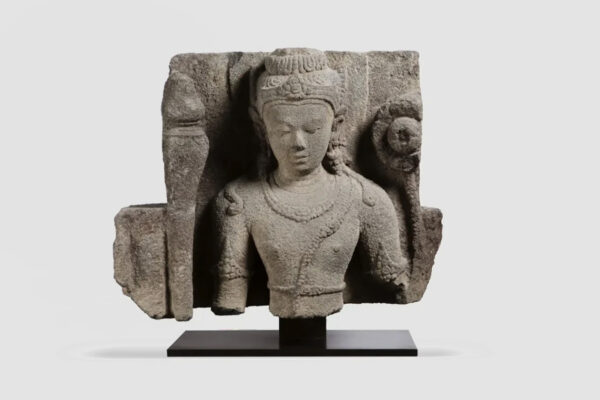Bronze estimate
Do you own an Asian bronze object and want to know its value? Whether you’re a passionate collector or have a family heirloom, having your bronze appraised is an essential step in understanding its true potential. Our Asian art experts will provide you with a free, confidential estimate within 48 hours, and will guide you through the entire process, whether you wish to sell at auction or simply find out the value of your piece.
Estimates and prices of Asian bronzes
Asian bronzes, particularly those of Chinese origin, have a rich history dating back over 3,000 years. Originally used in ritual and ceremonial contexts, these objects are now highly prized on the art market. Here’s a detailed guide to understanding the value of these pieces and how to recognize them.
Price table for Asian bronzes in 2024
In 2024, demand for Asian bronzes remains strong. Prices vary according to period, type of object and state of conservation:
| Object type | Low range (€) | Average range (€) | High range (€) |
|---|---|---|---|
| Ritual vases | 5 000 € | 50 000 € | 1 000 000 € |
| Figurines and statues | 2 000 € | 20 000 € | 500 000 € |
| Ritual objects (censers, lamps, etc.) | 1 000 € | 10 000 € | 200 000 € |
| Bell and gong | 500 € | 5 000 € | 50 000 € |
| Bronze mirrors | 300 € | 3 000 € | 30 000 € |
| Weapons and armor | 1 500 € | 15 000 € | 300 000 € |
| Modern bronzes | 1 000 € | 5 000 € | 100 000 € |
Why should I have my Asian bronze object appraised?
If you own an Asian bronze object and would like to know its value, you have several options for obtaining a reliable estimate:Obtaining an accurate estimate for your jade has several advantages:
For auction: If you’re planning to sell your jade, knowing its current value helps you set a fair and attractive price.
For insurance: In the event of a claim or damage, an estimate enables you to insure your room properly.
As part of an inheritance: If you have inherited a jade object, you may need an appraisal for inheritance tax purposes or to divide the inheritance fairly.
Curiosity: You may simply want to know the value of your jade, especially if it’s an heirloom or family heirloom.
How do you get your bronze appraised with Asium?
Nothing could be simpler! You can request an estimate directly online via our form. Simply upload photos of your bronze object and add a description. Our experts will get back to you within 48 hours with a confidential estimate.
For larger collections or high-value objects, we also offer in-home appraisal services or the possibility of participating in our appraisal days, where you can bring your jade for an in-person appraisal.
How to recognize an Asian bronze object?
It can be difficult to recognize a true Asian bronze, but here are a few criteria to consider:
- Marks and inscriptions: Look for engraved Chinese characters or seals. These inscriptions may indicate the dynasty or workshop of origin.
- Style and motifs: Compare the object with authentic examples, taking into account the motifs and styles typical of each period.
- Patina and wear: A natural patina, the result of time, is a good indicator of authenticity. Pay attention to signs of wear, which should be consistent with the age of the object.
- Manufacturing technique: Early bronzes were made using complex techniques such as lost-wax casting. Moulding lines or tool marks may indicate traditional manufacturing.
- Expert advice: To avoid counterfeits, it’s always best to call in a specialist to confirm the authenticity of your bronze.

How to recognize the value of an Asian bronze
When you hold your Asian bronze, there are several criteria that can help you determine its value. Here’s a detailed guide to help you assess your object accurately:
Authenticity: Examine your bronze on the base and sides for marks or inscriptions. Chinese characters, seals or inscriptions can indicate the object’s origin. For example, a Ming dynasty seal could considerably increase the value of your piece. Tap lightly on the object. A clear, resonant sound is often a good indicator of authenticity. A dull sound could indicate a less precious metal or an imitation.
Condition: Look for traces of manufacture, such as casting lines or hand finishing. Bronze made using the lost-wax technique often shows fine, meticulous detail. Hold your piece up to the light to appreciate the reflections and texture. If possible, compare your bronze with authentic examples found in books or online to verify the quality of workmanship.
Style and decoration: If you have information about the provenance of your bronze, this can influence its value. For example, a bronze that belonged to a well-known collection or a former aristocrat may be more valuable.
A brief history of Asian bronze
The history of Asian bronze dates back more than 3,000 years, with a striking debut in China during the Shang dynasty (1600-1046 BC). At that time, bronze was mainly used to create ritual objects, such as vases and cauldrons, for ancestral ceremonies. The lost-wax casting technique enabled the creation of highly precise pieces, highlighting the exceptional skills of the craftsmen.
Under the Zhou (1046-256 B.C.) and Qin (221-206 B.C.) dynasties, bronze production intensified, reflecting evolving artistic styles and religious beliefs. These objects also became symbols of social status and power, testifying to the political and cultural importance of their owners.
Over the centuries, Asian bronze has undergone various developments in other regions, such as India and Japan, where it has been used for sculptures, bells and musical instruments. Bronze art has continued to evolve, incorporating cultural and technical influences from dynasty to dynasty, right up to the present day, where antique pieces are sought after for their artistic and historical value.
Our experts in bronze
-

TaHsi CHANG
Specialist in the arts of VIETNAM and CHINA
-

Jean GAUCHET
ASIA Expert
-

Eunbi HA
Our areas of expertise
Your questions, our answers
How can I check the authenticity of an Asian bronze object before buying it?
To verify the authenticity of an Asian bronze, look for marks or inscriptions on the piece. Also look for signs of patina and wear consistent with its age. Finally, don’t hesitate to call in an Asian art expert for an in-depth appraisal.
What factors influence the value of Asian bronzes on today’s market?
The value of Asian bronzes depends on a number of factors, including the period of manufacture, state of preservation, provenance and rarity of the object. Older, well-preserved pieces are generally worth more.
What types of Asian bronze objects are most sought-after by collectors?
Statues of divinities, ritual vases and ancient bells are among the most sought-after items. Bronzes associated with prestigious dynasties, such as the Shang and Zhou, also attract a great deal of collector interest.
Previously appraised by Asium
The Asium estimation service is...

Simple
and free
A few photos of your work, a few words of description and you're all set !

Fast
but not too fast
Our experts are serious, they take the time to research and get back to you within a week.

Reliable
and confidential
Our auctioneers are the Sherlock Holmes of the art market.































